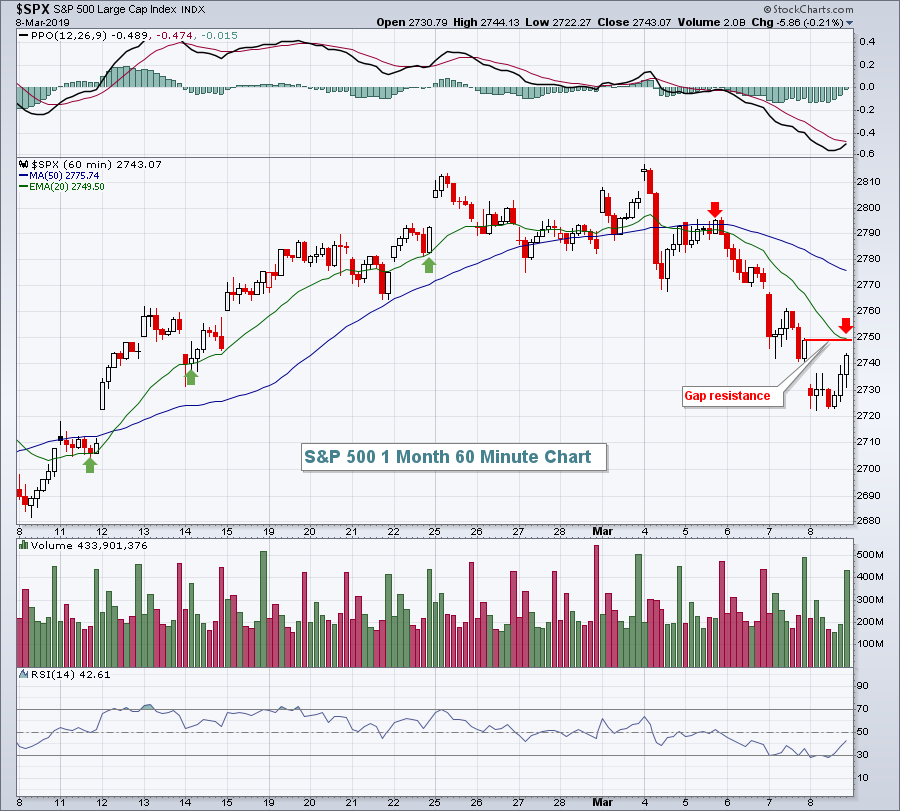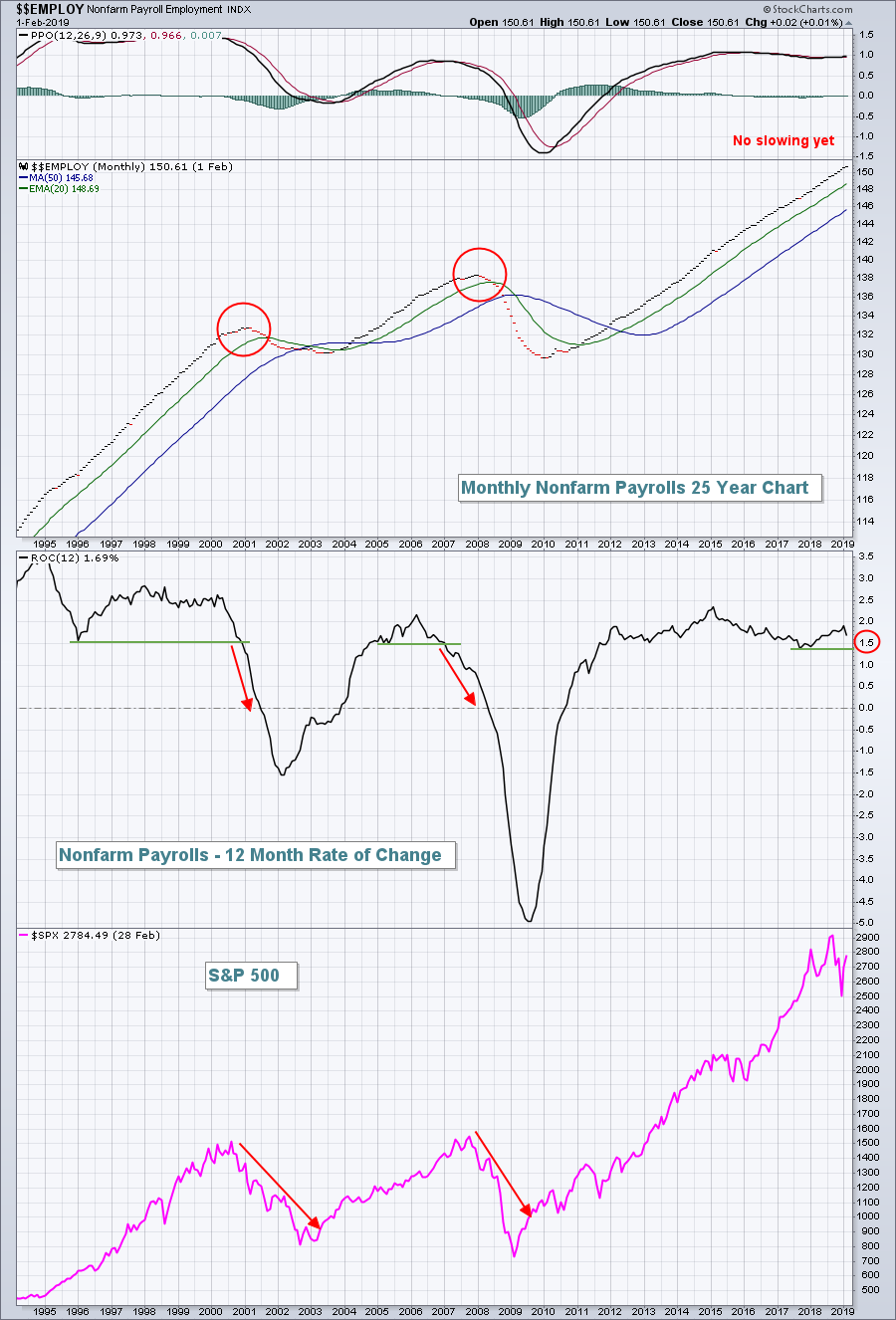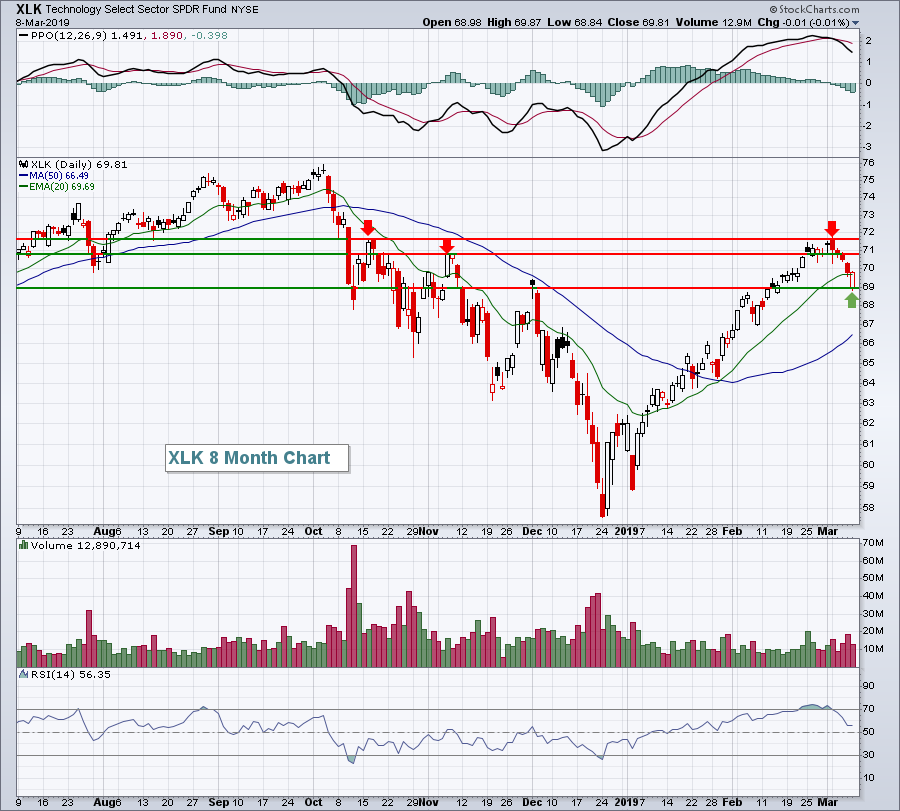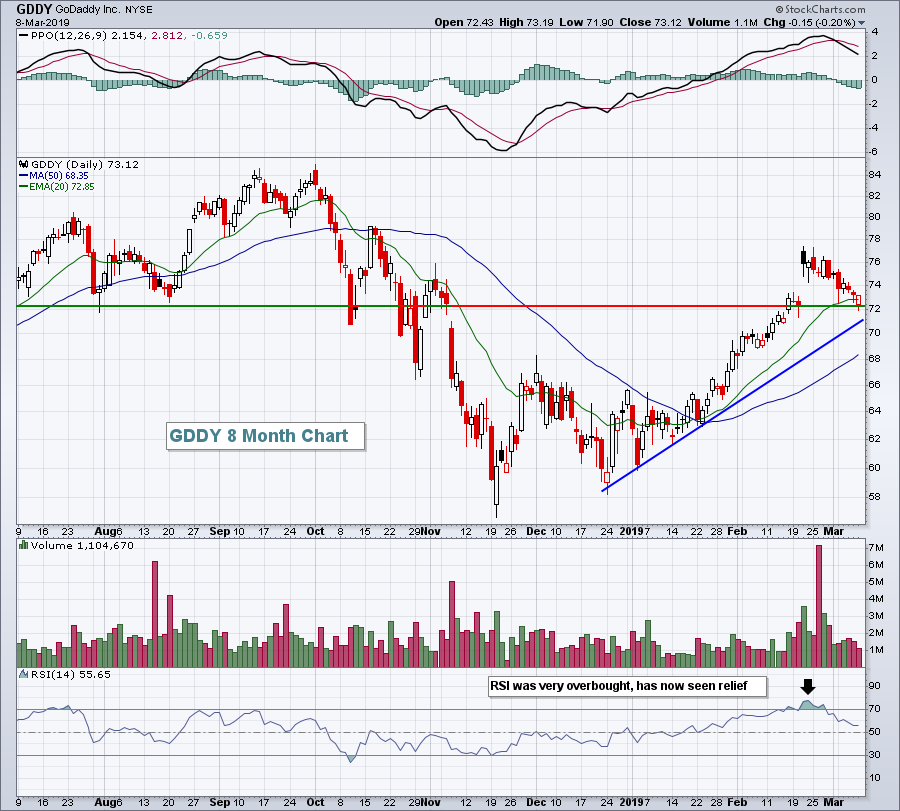Market Recap for Friday, March 8, 2019
Friday started ugly. There's no way to sugar coat the worst jobs report in 18 months. Nonfarm payrolls fell way short of expectations, 20,000 actual vs. 175,000 consensus estimate. Slowing job growth was an excellent predictor of the last two bear markets, so this shortfall cannot be underestimated. But....it was just one report and it comes on the heels of the recent government shutdown and in the midst of the lingering US-China trade war. It also comes one month after an unusually strong January nonfarm payrolls that crushed estimates.
Despite the weak jobs report, huge gap down and all of our major indices beneath their respective 20 day EMAs, buyers returned to nearly send the indices into positive territory. While the reversal was certainly excellent news for the bulls, an approaching test of the declining 20 hour EMA awaits the bulls early in today's session:
 Gap resistance and the declining 20 day EMA both meet just beneath 2750. That should be viewed as key resistance in the very near-term. Breaking back above 2750 and holding that level would be a definite win for the bulls.
Gap resistance and the declining 20 day EMA both meet just beneath 2750. That should be viewed as key resistance in the very near-term. Breaking back above 2750 and holding that level would be a definite win for the bulls.
Energy (XLE, -1.87%) was the big loser on Friday as crude oil prices ($WTIC, -1.04%) dropped. Intraday, the WTIC was well below its 20 day EMA, but did manage to climb back above it by Friday's close, a short-term victory. Nonetheless, there were key breakdowns in energy to include exploration & production stocks ($DJUSOS, -3.22%):
 The two-month consolidation period ended in not-so-glorious fashion. The group certainly appears to have rolled over with December lows now a real possibility. It's also noteworthy that the PPO has returned to negative territory as bears reclaim control here.
The two-month consolidation period ended in not-so-glorious fashion. The group certainly appears to have rolled over with December lows now a real possibility. It's also noteworthy that the PPO has returned to negative territory as bears reclaim control here.
The good news is that aggressive areas of the market saw big reversals intraday with many closing on or near their Friday high. This would include technology (XLK, -0.01%), financials (XLF, -0.04%), and communication services (XLC, -0.06%). Consumer discretionary (XLY, -0.70%) definitely struggled on a relative basis, but should catch a break this morning with better-than-expected retail sales for January reported.
Pre-Market Action
A second Boeing (BA) 737 MAX-8 plane crashed over the weekend, this time in Ethiopa, and that has put tremendous pressure on BA's stock in pre-market action, down more than 12% at last check. That has put significant pressure on Dow Jones futures, which are currently down close to 200 points. S&P 500 and NASDAQ futures are slightly positive, however, as weakness is concentrated mostly in BA.
January retail sales came in better than expected, especially if we strip out autos, climbing 0.9% vs. the estimate of 0.3%. That should help the retail group today.
Asian markets were strong overnight and Europe is higher this morning, providing a solid start to global markets this week.
Current Outlook
One economic report that it simply makes good common sense to track is job growth. A strong economy should result in job creation so following the rate of change (ROC) of monthly jobs would seem to make sense. The chart backs me up on this one:
 The red circles show job growth slowing at the start of the two prior bear markets. The 1.5% job growth level has been a key area in the past (little red circle on right) and we went just a bit below that level in late 2017. A return below 1.50 and losing that late-2017 support would be a major fundamental worry and, if accompanied by a technical price breakdown, would be major cause for concern for us chartists. While it's something to watch closely over the next few months, I wouldn't panic out of equities now. Let's see if jobs stabilize and move back higher when the next release occurs on the first Friday in April.
The red circles show job growth slowing at the start of the two prior bear markets. The 1.5% job growth level has been a key area in the past (little red circle on right) and we went just a bit below that level in late 2017. A return below 1.50 and losing that late-2017 support would be a major fundamental worry and, if accompanied by a technical price breakdown, would be major cause for concern for us chartists. While it's something to watch closely over the next few months, I wouldn't panic out of equities now. Let's see if jobs stabilize and move back higher when the next release occurs on the first Friday in April.
Sector/Industry Watch
Technology (XLK, -0.01%) was able to work its way back to essentially unchanged on Friday after an opening gap lower. More importantly, however, it was able to close back above its 20 day EMA, printing a reversing hollow candle in the process:
 Critical overhead price resistance was already established and tested at 71.64, so that's clearly the top end of the current price range. Friday's gap open at 68.98 marks an important short-term price support level now. That's the range I'd watch for now, 68.98-71.64. Technology is a very important component of the market. Let's see which end of the trading range breaks first. That'll give us our next clue as to short- to intermediate-term market direction.
Critical overhead price resistance was already established and tested at 71.64, so that's clearly the top end of the current price range. Friday's gap open at 68.98 marks an important short-term price support level now. That's the range I'd watch for now, 68.98-71.64. Technology is a very important component of the market. Let's see which end of the trading range breaks first. That'll give us our next clue as to short- to intermediate-term market direction.
Monday Setups
Internet stocks ($DJUSNS) bounced beautifully off their rising 20 day EMA test, which brings me to this week's Monday Setup - GoDaddy, Inc. (GDDY). GDDY reported excellent quarterly results a couple weeks ago, gapped substantially higher, and now has worked its way back down to gap support and its 20 day EMA:
 The rising trendline near 71 could be used as a closing stop while looking for a target closer to 77 to retest the post-earnings high.
The rising trendline near 71 could be used as a closing stop while looking for a target closer to 77 to retest the post-earnings high.
Historical Tendencies
We begin a historical bullish period today. The S&P 500 has produced annualized returns four times greater than normal this week and through next Monday, March 18th.
Key Earnings Reports
(reports after close, estimate provided):
COUP: .00
Key Economic Reports
January retail sales released at 8:30am EST: +0.2% (actual) vs. +0.1% (estimate)
January retail sales less autos released at 8:30am EST: +0.9% (actual) vs. +0.3% (estimate)
December business inventories to be released at 10:00am EST: +0.6% (estimate)
Happy trading!
Tom






